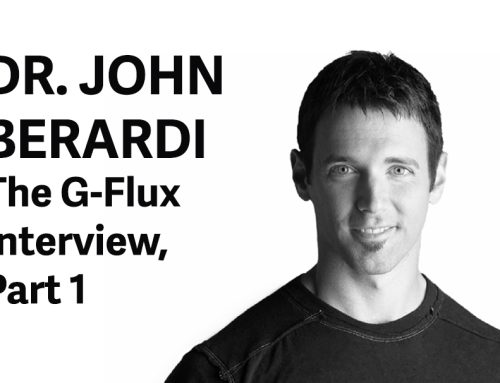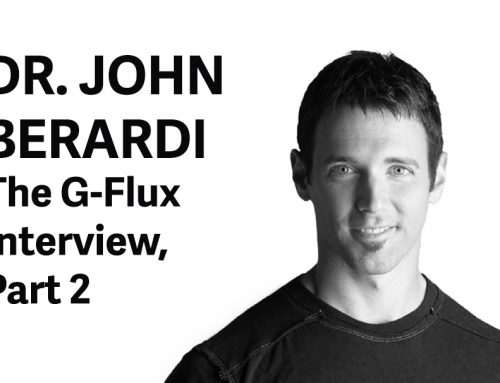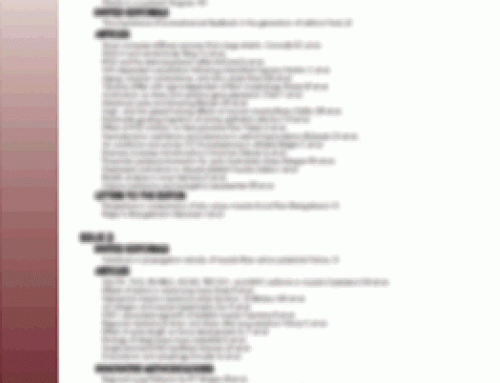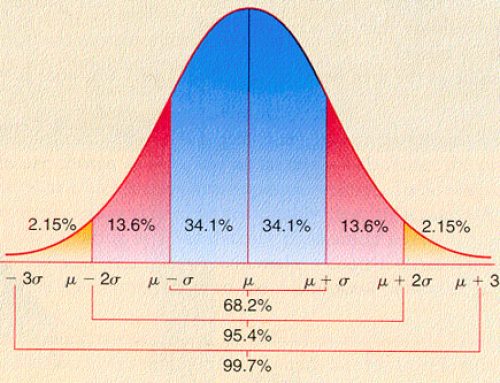In my last post, I introduced Dr. John Berardi’s concept of increasing energy flux (“G-flux) to improve your body composition.. ie, less fat, more muscle… and best part… you get to eat more! We discussed the definition of G-flux, we touched on how it works, and why the low calorie approach may not be the long-life solution that certain “life extensionists” pronounce it to be. In part two, you will discover what else will happen to you if you choose the diet without exercise approach, you’ll learn the nutritional benefits of a higher G-flux lifestyle and you’ll learn the truth about overtraining…
Continued from part one
Tom Venuto: If somebody decides to just eat less and not exercise, which is the case for many popular diet programs, what is the impact on performance, metabolism and body composition short term and also long term?
John Berardi: Well, for starters, choosing not to exercise is a huge mistake for anyone, regardless of their goals. The human body was built for exercise and, over time, has developed with exercise as a survival necessity.
Yet nowadays exercise has become unnecessary for survival and, on the whole, our society has become sedentary. This has lead to huge health and body composition problems.
Plain and simple, it’s a fool’s choice not to exercise.
Yet let’s say someone simply won’t exercise. In that case, eating less (while still eating well) is certainly better than eating whatever they feel like, whenever they feel like it – which will usually lead to overfeeding and under nourishing.
However, assuming the no exercise, low calorie scenario, problems can still develop. For starters, muscle and bone mass will likely be lost. This means long-term problems like osteoporosis and sarcopenia. In other words, get ready for the nursing home.
Also, metabolic power diminishes. Eating less while not exercising is like rapidly downshifting the metabolism. And this means that when the “diet” ends, it’s quite easy to gain fat.
In the end, the body finds it very hard to balance energy intake and output when sedentary. So even if you try to undereat your energy expenditure, if you’re not exercising, you’re likely losing muscle and losing metabolism throughout your diet. So you’d have to continually drop calories in a never-ending downward spiral of muscle loss, metabolic loss, and calorie deprivation. This is a battle most can’t win!
The beauty of high levels of G-Flux is that when the body is very physically active, it tends to find new energy balance points without rigorously counting calories, etc. Therefore it’s easier to be in great shape when G-Flux is high. In my seminars I devote an entire section to this idea – improving body composition without counting calories.
Tom Venuto: If you’re eating more and training more, obviously this allows you a higher intake of amino acids, essential fatty acids, fiber, vitamins, minerals and phytonutrients. Is this an important benefit of the higher G-flux approach or can nutritional supplements make up for lower intakes of these nutrients at low energy intakes? And on the flip side, if you’re taking in copious amounts and a wide variety of whole foods, which high energy intake allows you to do, are many supplements really necessary?
John Berardi: You got it, Tom. I believe that the high intake of vitamins, minerals, phytonutrients, fiber, etc. is one of the greatest and most overlooked advantages of the G-Flux approach. Higher intakes of these nutrients (when accompanied by a high G-Flux) can lead to better health, better nutrient partitioning, lower disease risk and more. So you end up with more exercise (which leads to a better health profile and less body fat) and more high quality nutrition (which also leads to a better health profile and better body composition). You can’t go wrong there.
Specific to your question, assuming one decides to follow a low-flux lifestyle; nutritional supplements do become very important. Low exercise volume means less food eaten (assuming you want to stay lean and healthy). And less food eaten means fewer nutrients. With the vitamin and mineral contents of our fruits and veggies somewhat lower than they have been in the past, each serving of fruit and veggie contains less of the important, health-promoting nutrients.
Therefore we either have to eat more of them or we have to supplement with multi-vitamin/multi-mineral formulas and greens food products (for our phytochemicals). In fact, both the Journal of the American Medical Association and the British Medical Journal have recommended daily multi-vitamin supplements for this reason.
Often times, competitive bodybuilders have to move toward a lower flux lifestyle in an attempt to get very lean for the competitive stage. While their exercise volume remains quite high, their calorie intake can go quite low. This is because they need to achieve extreme levels of muscularity and low body fat. As a result, in each of these athletes I’m very conscious of supplementing with a multi-vitamin and mineral as well as a green food product. I’m also sure to recommend fish oil supplements. This helps these athletes get their essential nutrients while keeping their calories very low for short periods of time.
However, on the flip side, if an athlete of mine is exercising with fairly high volumes and eating their recommended 10-15 servings of fruits and veggies each day, their need for multi-vitamin/multimineral supplements is reduced. In fact, a number of my more disciplined Olympic and Pro athletes take no additional vitamins/minerals beyond what they get in their whole foods. And I prefer it this way as the vitamins, minerals, and phytonutrients present in whole foods are often better than commercially available supplements.
Tom Venuto: So if we’re going to increase energy flux that means more training, but what about overtraining? Is overtraining as much of a problem as the fitness and bodybuilding media make it out to be? Someone once said that there is no such thing as overtraining, only under nutrition. Is there any truth there or is that statement going too far?
John Berardi: Overtraining is a very real phenomenon although I guarantee that most people reading this have never been over trained. Heck, I bet they’ve never even met someone who’s been legitimately over trained. The only athletes I’ve ever seen over trained have been high level Olympians who train in excess of 20 hours per week for years at a time.
You see, overtraining is a real syndrome characterized by a host of psychological and physiological symptoms. And this syndrome is one that takes months of high volume training to develop. Further, once legitimately over trained, it can take 8-12 months to recover from.
Now that this is cleared up, we can discuss what most people think of as over training – central nervous system fatigue. CNS fatigue manifests in some of the same ways as over training although it can be developed over a much shorter period of time and is fairly easy to recover from with a planned break.
To this end, CNS fatigue can very well become an issue with high levels of G-Flux if someone isn’t careful to diversify their exercise profile. Trying to accomplish a high level of G-Flux with all high-intensity exercise is a recipe for CNS fatigue.
However, when some low intensity work is thrown into the mix, CNS recovery is much improved. This is because high intensity work stimulates the sympathetic nervous syste
m (fight or flight) while low intensity work stimulates the parasympathetic nervous system (rest and digest). The balance between these two types of exercise is important, as originally proposed by Hans Selye in the 50s. It’s sort of a yin and yang thing.
So, although overtraining isn’t likely for the recreationally active, CNS fatigue can manifest if a proper balance of high and low intensity exercise isn’t achieved.
Copyright BurnTheFatBlog.com. No reproduction of this article permitted.
This interview will conclude in part 3.
This was an excerpt of Tom venuto’s exclusive interview with Dr. berardi. To read the entire unedited G-Flux Interview, visit www.burnthefatinnercircle.com (members only)
For more information on Dr. John Berardi’s nutrition methods, visit www.PrecisionNutritionSystem.com
For more information on Tom Venuto’s Burn The Fat, Feed The Muscle method of fat loss visit: www.BurnTheFat.com
Dr. Berardi has two upcoming G-Flux seminars, one in Boston on May 5th and 6th (with Eric cressey) and one in Denver on May 19th & 20th. For more information visit: www.johnberardi.com








This is great, It’s what I’ve been hearing in Tom’s newsletters and book. It makes me shake my head because for years I was to lazy to exercise and just restricted calories and gone on crazy diets. It’s only recently after joining WW, and then getting Tom’s book I’ve really started to understand the gflux principle. It is so simple and logical, and EFFECTIVE. Using Tom’s pleateau buster ideas, and stepping it up has seen my plateau start to tip in my favor. But only after I stopped trying to starve and break out of the casual exercise routine, have I been able to really start to understand what my body is doing and why.It’s also echoes something I read recently from Sparkpeople.com “When you change your attitude about physical activity, you will inevitably change your body.” Carrie Myers Smith, Health & Fitness Writer.
Tom, the first article talked of low intensity exercise in combination with weight training. I’m not sure if I am confusing terms here but is low-intensity exercise not the opposite to what you advocate in BFFM? I seem to remember your approach was to do cardio at high intensities (75% of max) for longer periods?
Damian, in Part 3 (just published) John gives specifics of how he recommends mixing high intensity cardio (such as interval training) with lower intenstiy cardio and other physical activity.The trend today with many fitness professionals is to recommend high intensity interval training and rightly so, as it is time efficient and effective. It is not for everyone however. beginners should start with less intense forms of exercise and progress slowly – so low intensity exercise is appropriate in this case.Also, it may not be wise to perform intense interval training daily, so, as dr berardi points out, alternating intense cardio with moderate cardio or recreational exercise is a great way to keep your energy expenditure up (high g flux) without risking injury, etcIn my burn the fat program I give 70-85% of age predicted maximal heart rate (“target heart rate’) merely as a general guideline for cardio intensity level to get good results. intensities may exceed 85% during interval training. I prefer to use target heart rate more as a reference point than a prescription, as actual heart rates can vary quite a bit from person to person and ultimately you have to master the concept of perceived exertion.the “fat burn zone” is a myth — this says that you should Intentionally slow down and perform cardio slower to burn more fat. It is correct that your body will use more fat in the fuel mix as opposed to carbs with low intensity. The trouble is with very low intensity exercise, you hardly burn any calories so you dont burn much of anything.This is very intuitive and common sense, really if you think about it… what burns more fat… slow casual walk in the part where you dont even break a sweat, or a workout where you push yourself and your heart is pounding and sweat is pouring, etcHigher intensity cardio burns more calories so is more efficient. Even when i perform longer duration sessions (40-45 min or so) i still push up the intensity so its “moderate” not “low” in intensity.